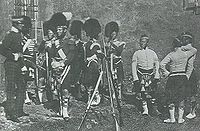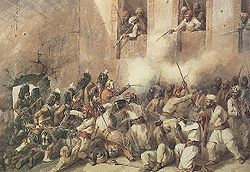
William George Drummond Stewart
Encyclopedia
William George Drummond Stewart VC
(February 1831 - 19 October 1868) was a Scottish
recipient of the Victoria Cross
, the highest and most prestigious award for gallantry in the face of the enemy that can be awarded to British
and Commonwealth
forces.
“Captain Stewart was an officer of remarkable coolness in action, nothing ever appearing to disturb his equanimity in the very slightest degree.”.
Battersby). He was born in February 1831 in Grandtully, Perthshire.
He entered the Army on 2 June 1847 as an Ensign in the 93rd Sutherland Highlanders. After four years home service, he attained his promotion as Lieutenant, becoming a Captain two years later on 29 December 1854. In February 1854, on the outbreak of war with Russia, the 93rd Highlanders embarked for the Crimea
, where they were destined to see much fighting and to win great renown.
Stewart was present at the Battle of Alma
on 20 September that year, when the 93rd, as part of the Highland Brigade
, 1st Division, stormed the Great Russian Battery on the Alma Heights with the other Highland Regiments and Foot Guards (93rd losses: 1 officer, 54 men). He was also present at the Battle of Balaklava a month later on 25 October, where the 93rd alone formed the now famous 'Thin Red Line
' which, unsupported, repulsed the charge of a large body of the enemy’s cavalry, and thereby prevented a direct assault on the port of Balaklava. He also served in the Siege of Sevastopol through the winter of 1854/5. He was wounded in the trenches above the besieged port, and remained in the Crimea until July 1856, when his regiment returned to England.
For his services in the Campaign, Stewart received the Crimean Medal with clasp for Alma, Balaclava and Sebastopol, the Turkish Medal and the Order of the Medjidie (5th class)
.
's advance to relieve the Siege of Lucknow
. The heroic achievements of Sir Colin’s few forces are now matters of history, foremost among them stand the operations of 16 November: the Capture of the Secunderabagh and the Shah Najaf, deeds with which the name of the 93rd will ever be associated.
While the artillery was being brought to bear on the Sikandarabagh, Capt. Stewart, with some Highlanders and a few of the 53rd Regiment of Foot
, advanced towards two of the enemy’s guns, which were maintaining a heavy flanking fire and which covered the approach to the barracks, a large cross-shaped building surrounded by outhouses. Stewart captured the guns in a most gallant manner, and by this means his force was able to gain possession of the barracks . Field Marshal The Lord Roberts
described the action as "serviceable as it was heroic, for it silenced the fire most destructive to the attacking force". The possession of this building secured the left of the British advance, and greatly facilitated the ultimate withdrawal of the garrison of Lucknow.


 Stewart was 26 years old, and a Captain
Stewart was 26 years old, and a Captain
in the 93rd (Sutherland) Highlanders
when he was awarded the Victoria Cross for his above actions at Lucknow. He was gazetted on 24 December 1858 and his citation read:
Six Victoria Crosses in all were bestowed on the 93rd Highlanders for their gallantry on the 16th November, but Sir Colin Campbell decided, perhaps fearing that he might be accused of partiality, that only one of these should be given to the officers. Votes were taken and Capt. Stewart was chosen by his brother officers to receive the much prized honour. A total of 24 Victoria Crosses were awarded to British forces at Lucknow on 16 November 1857, the largest number ever awarded in a single day.
After the withdrawal of the Lucknow garrison, Sir Colin’s Army was hurried back to Cawnpore. Stewart took part in the great battle which ensued there on the 6th Dec. His regiment was in the thick of the fighting, and two days later, it formed part of the force under Sir Hope Grant. It completed the destruction of the Gwalior rebels as they were attempting to cross the Ganges at Oude. After two months of minor operations, the 93rd fought its way in to Lucknow under Sir Colin Campbell, and distinguished itself as on the previous occasion. Stewart took part in the storming of the Mogum’s Palace on 11 March 1858,and, with characteristic daring, led a small party beyond the building in pursuit of the mutineers.
With Lucknow captured, the 93rd was sent into Rohilkand under Brigadier-General Walpole, helped to defeat the enemy at Alaganj, and fought under Sir Colin Campbell at Bareilly
. There the regiment remained throughout the hot weather. In the following winter, it took part in the pacification of Oude, which was finally accomplished by the beginning of 1859.
For his services in this campaign, besides the Victoria Cross, Capt. Stewart received the mutiny medal
with clasp for Lucknow.
William Stewart was promoted Major but left the Army in 1860. On 19 October 1868, while at Hythe, Hampshire, Stewart was giving a demonstration of sword swallowing
. His trick went fatally wrong and he died from internal injuries a week later, on 26 October. William Stewart predeceased his father.
Victoria Cross
The Victoria Cross is the highest military decoration awarded for valour "in the face of the enemy" to members of the armed forces of various Commonwealth countries, and previous British Empire territories....
(February 1831 - 19 October 1868) was a Scottish
Scotland
Scotland is a country that is part of the United Kingdom. Occupying the northern third of the island of Great Britain, it shares a border with England to the south and is bounded by the North Sea to the east, the Atlantic Ocean to the north and west, and the North Channel and Irish Sea to the...
recipient of the Victoria Cross
Victoria Cross
The Victoria Cross is the highest military decoration awarded for valour "in the face of the enemy" to members of the armed forces of various Commonwealth countries, and previous British Empire territories....
, the highest and most prestigious award for gallantry in the face of the enemy that can be awarded to British
United Kingdom
The United Kingdom of Great Britain and Northern IrelandIn the United Kingdom and Dependencies, other languages have been officially recognised as legitimate autochthonous languages under the European Charter for Regional or Minority Languages...
and Commonwealth
Commonwealth of Nations
The Commonwealth of Nations, normally referred to as the Commonwealth and formerly known as the British Commonwealth, is an intergovernmental organisation of fifty-four independent member states...
forces.
“Captain Stewart was an officer of remarkable coolness in action, nothing ever appearing to disturb his equanimity in the very slightest degree.”.
Crimean War
George (as he was known) Stewart was the son of Captain Sir William Drummond Stewart, 19th Laird of Grantully and 7th Baronet of Murthly, and his wife Maria Christina (néeNEE
NEE is a political protest group whose goal was to provide an alternative for voters who are unhappy with all political parties at hand in Belgium, where voting is compulsory.The NEE party was founded in 2005 in Antwerp...
Battersby). He was born in February 1831 in Grandtully, Perthshire.
He entered the Army on 2 June 1847 as an Ensign in the 93rd Sutherland Highlanders. After four years home service, he attained his promotion as Lieutenant, becoming a Captain two years later on 29 December 1854. In February 1854, on the outbreak of war with Russia, the 93rd Highlanders embarked for the Crimea
Crimea
Crimea , or the Autonomous Republic of Crimea , is a sub-national unit, an autonomous republic, of Ukraine. It is located on the northern coast of the Black Sea, occupying a peninsula of the same name...
, where they were destined to see much fighting and to win great renown.
Stewart was present at the Battle of Alma
Battle of Alma
The Battle of the Alma , which is usually considered the first battle of the Crimean War , took place just south of the River Alma in the Crimea. An Anglo-French force under General St...
on 20 September that year, when the 93rd, as part of the Highland Brigade
Highland Brigade (Scottish)
The Highland Brigade is a historical unit of the British Army, which has been formed a number of times. It recruited men from the Highlands of Scotland.-Crimean War:...
, 1st Division, stormed the Great Russian Battery on the Alma Heights with the other Highland Regiments and Foot Guards (93rd losses: 1 officer, 54 men). He was also present at the Battle of Balaklava a month later on 25 October, where the 93rd alone formed the now famous 'Thin Red Line
The Thin Red Line (1854 battle)
The Thin Red Line was a military action by the Sutherland Highlanders red-coated 93rd Regiment at the Battle of Balaclava on October 25, 1854, during the Crimean War. In this incident the 93rd aided by a small force of Royal Marines and some Turkish infantrymen, led by Sir Colin Campbell, routed a...
' which, unsupported, repulsed the charge of a large body of the enemy’s cavalry, and thereby prevented a direct assault on the port of Balaklava. He also served in the Siege of Sevastopol through the winter of 1854/5. He was wounded in the trenches above the besieged port, and remained in the Crimea until July 1856, when his regiment returned to England.
For his services in the Campaign, Stewart received the Crimean Medal with clasp for Alma, Balaclava and Sebastopol, the Turkish Medal and the Order of the Medjidie (5th class)
Medjidie
Medjidie or Mejidie is the name of a military and knightly order of the Ottoman Empire. The Order was instituted in 1851 by Sultan Abdülmecid I.-Order of the Medjidie:...
.
Indian Mutiny
The following summer found the 93rd on its way to India, where the laurels gained in the Crimea were to be more than doubled. The regiment reached Calcutta in September 1857, just in time to join Sir Colin CampbellColin Campbell, 1st Baron Clyde
Field Marshal Colin Campbell, 1st Baron Clyde GCB, KSI was a British Army officer from Scotland who led the Highland Brigade in the Crimea and was in command of the ‘Thin red line’ at the battle of Balaclava...
's advance to relieve the Siege of Lucknow
Siege of Lucknow
The Siege of Lucknow was the prolonged defense of the Residency within the city of Lucknow during the Indian Rebellion of 1857. After two successive relief attempts had reached the city, the defenders and civilians were evacuated from the Residency, which was abandoned.Lucknow was the capital of...
. The heroic achievements of Sir Colin’s few forces are now matters of history, foremost among them stand the operations of 16 November: the Capture of the Secunderabagh and the Shah Najaf, deeds with which the name of the 93rd will ever be associated.
While the artillery was being brought to bear on the Sikandarabagh, Capt. Stewart, with some Highlanders and a few of the 53rd Regiment of Foot
53rd Regiment of Foot
The 53rd Regiment of Foot was a British Army regiment founded in 1755. In 1881, as part of the Childers Reforms, it became The King's Shropshire Light Infantry Regiment. Its traditions are currently held by the 3rd battalion of The Light Infantry....
, advanced towards two of the enemy’s guns, which were maintaining a heavy flanking fire and which covered the approach to the barracks, a large cross-shaped building surrounded by outhouses. Stewart captured the guns in a most gallant manner, and by this means his force was able to gain possession of the barracks . Field Marshal The Lord Roberts
Frederick Roberts, 1st Earl Roberts
Field Marshal Frederick Sleigh Roberts, 1st Earl Roberts, Bt, VC, KG, KP, GCB, OM, GCSI, GCIE, KStJ, PC was a distinguished Indian born British soldier who regarded himself as Anglo-Irish and one of the most successful British commanders of the 19th century.-Early life:Born at Cawnpore, India, on...
described the action as "serviceable as it was heroic, for it silenced the fire most destructive to the attacking force". The possession of this building secured the left of the British advance, and greatly facilitated the ultimate withdrawal of the garrison of Lucknow.
“Stewart, perceiving the annoyance which these two guns were causing, and the injury that they might still cause, called upon his company (No.2), and at the head of it, increased in weight and numbers by a few men of the other companies, and of the 53rd, who had joined our men, dashed forward in the most gallant style, captured the guns at the point of the bayonet, turned the guns on the flying rebels, and then, pushing forward at the double, while Captain Cornwall, with his company (No.3) and the men of other companies, followed in support, assaulted the large pile of building called the barracks, situated in the left front of the Sikanderbagh, drove the enemy out, and established themselves in it”.



Captain (British Army and Royal Marines)
Captain is a junior officer rank of the British Army and Royal Marines. It ranks above Lieutenant and below Major and has a NATO ranking code of OF-2. The rank is equivalent to a Lieutenant in the Royal Navy and to a Flight Lieutenant in the Royal Air Force...
in the 93rd (Sutherland) Highlanders
93rd Regiment of Foot
The 93rd Regiment of Foot was a Line Infantry Regiment of the British Army . In 1881 during the Childers Reforms it was united with the 91st Regiment of Foot to form the Argyll and Sutherland Highlanders .- The 93rd Regiment :The 93rd Regiment was raised three times before it became the...
when he was awarded the Victoria Cross for his above actions at Lucknow. He was gazetted on 24 December 1858 and his citation read:
Six Victoria Crosses in all were bestowed on the 93rd Highlanders for their gallantry on the 16th November, but Sir Colin Campbell decided, perhaps fearing that he might be accused of partiality, that only one of these should be given to the officers. Votes were taken and Capt. Stewart was chosen by his brother officers to receive the much prized honour. A total of 24 Victoria Crosses were awarded to British forces at Lucknow on 16 November 1857, the largest number ever awarded in a single day.
After the withdrawal of the Lucknow garrison, Sir Colin’s Army was hurried back to Cawnpore. Stewart took part in the great battle which ensued there on the 6th Dec. His regiment was in the thick of the fighting, and two days later, it formed part of the force under Sir Hope Grant. It completed the destruction of the Gwalior rebels as they were attempting to cross the Ganges at Oude. After two months of minor operations, the 93rd fought its way in to Lucknow under Sir Colin Campbell, and distinguished itself as on the previous occasion. Stewart took part in the storming of the Mogum’s Palace on 11 March 1858,and, with characteristic daring, led a small party beyond the building in pursuit of the mutineers.
With Lucknow captured, the 93rd was sent into Rohilkand under Brigadier-General Walpole, helped to defeat the enemy at Alaganj, and fought under Sir Colin Campbell at Bareilly
Bareilly
Bareilly is a prominent city in Bareilly district in the northern Indian state of Uttar Pradesh. Standing on the Ramganga river, it is the capital of the Bareilly division and the geographical region Rohilkhand...
. There the regiment remained throughout the hot weather. In the following winter, it took part in the pacification of Oude, which was finally accomplished by the beginning of 1859.
For his services in this campaign, besides the Victoria Cross, Capt. Stewart received the mutiny medal
Indian Mutiny Medal
The Indian Mutiny Medal was a campaign medal approved in 1858, for issue to officers and men of British and Indian units who served in operations in suppression of the Indian Mutiny....
with clasp for Lucknow.
William Stewart was promoted Major but left the Army in 1860. On 19 October 1868, while at Hythe, Hampshire, Stewart was giving a demonstration of sword swallowing
Sword swallowing
Sword swallowing is an ancient performance art in which the performer passes a sword through the mouth and down the esophagus towards the stomach...
. His trick went fatally wrong and he died from internal injuries a week later, on 26 October. William Stewart predeceased his father.
See also
- List of Indian Mutiny Victoria Cross recipients
- List of Victoria Cross recipients (N–Z)
- List of Scottish Victoria Cross recipients

